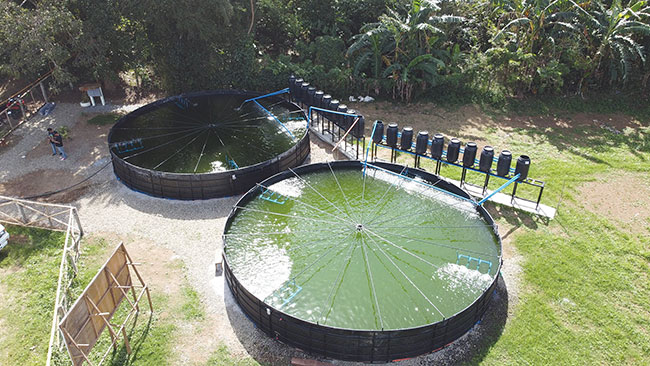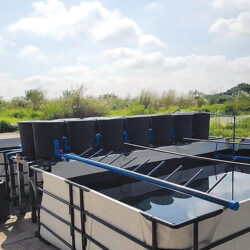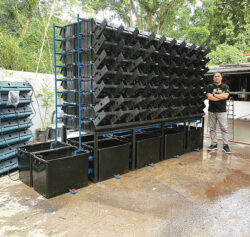
Features
Technology
Shrimp
Portable system to democratize sustainable aquafarming in the Philippines
August 2, 2023 By Ruby Gonzalez
 Photos: AGRITEKTURA
Photos: AGRITEKTURA There is such a thing as having too much or having too little. And then, there is the case of having it just right.
An architect-farmer in the Philippines seems to have struck the right balance with an “aquatecture” system he developed called the portaShip. An acronym for Portable, Sustainable, Smart, Holistic, Healthy, Integrated & Interactive Product for aquafarming, the system was designed and developed for community-scale aquafarmers by Agritektura Enterprises.
“The concept came in when I thought of an affordable sustainable aquafarming system,” Francis (Ran) Quijano, prime mover at Agritektura, told Hatchery International.
“So, the portaSHIP fits the idea of making aquafarming sustainable in the urban settings. Considering that urban spaces are expensive, the system I created must be impermanent,” he said, implying that the unit could be easily relocated should the space be up for redevelopment.
Farming potential
With the ever-increasing demand for fish, together with the favourable environment in the Philippines, many have cast their eyes to fish farming. At the onset, though, ground-zero financial requirements keep these aspiring aquafarmers at bay.
“Start-up communities and associations find it hard to operate aquafarming due to the fund requirements,” he said. “The idea of the portaSHIP paved way for aquafarmers to start small and in a controlled environment that ensures quality and user-friendly monitoring system.”
Quijano said interested parties have access to government grants, angel investors and community seed funds. The company, which has an established track record, is working closely with government agencies such as the Bureau of Fisheries and Aquatic Resources and the Department of Science and Technology.
Prototyping
The portaShip features specialized modular construction system, solar energy system and automation for the systems on aeration, filtration and nutrition.
The structure’s frame uses Schedule 40 steel pipe with steel matting wall support, turnbuckle top support and flatbar bottom support. The pond is made of high-grade tarpaulin with net cover. Filtration uses stone filter composed of filter cloth, filter brush, Japanese mat, K1 media and stone filter. For aeration, there are Venturi bottom aerators and support top aeration using smart aquapumps and degas aerator.
“I am partnering now with DOST Metals Industry Research and Development Center and the Mindoro State University in developing an automated water quality monitoring gadget,” he said.
The portaShip has already been applied in three design prototypes.
 The circular portaShip is designed for mass production/bulk production fit for communities. It has the capacity for 10,000 pieces if tilapia and 30,000 pieces of shrimps.
The circular portaShip is designed for mass production/bulk production fit for communities. It has the capacity for 10,000 pieces if tilapia and 30,000 pieces of shrimps.
The box portaShip might be ideal for restaurants and can produce 3,000 pieces tilapia and 9,000 pieces of shrimps.
The third design is a vertical system for crab-fattening and soft-shell production.
Stocking to harvest time takes four to five months for tilapia and between three to four months for shrimp. Survival rate in circular and box systems have been between 70 to 80 per cent.
Logistical factors add to the attractiveness of the portaShip. Onsite installation of a unit takes only one to two days of fabrication. To compare, construction of a concrete pond could consumer two to three months. Based on the volume of harvest, cost of portaSHIP can be anywhere from 25 to 50 per cent lower than the construction cost of concrete pond.
One to two persons are enough to operate one unit of portaShip.
Quality is one of the anchors of sustainability. Quijano said he referred to the Philippine Bureau of Fisheries and Aquatic Resources (BFAR) as well as other feed company resources to formulate his own “user-friendly system for feeding protocols for fingerlings.
The vannamei and tilapia parameter guide for morning and afternoon enumerates acceptable levels for pH, dissolved oxygen, salinity, total ammonia, nitrite and transparency. For tilapia there are additional for parameters for stocking and temperature.
“The portaShip is portable but highly intensive,” Quijano stressed.
Starting up
Since the launch, portaShip clients have mostly been startups. “We are still in the prototype stage. We partnered with clients who understand that we are perfecting the product,” he said.
 After the first product launch, Quijano and his team didn’t ease up on research and development. One particular focus was the filter system.
After the first product launch, Quijano and his team didn’t ease up on research and development. One particular focus was the filter system.
“Concerns such as the effective filter system that will enable the cooperators to access to a technology that is affordable and efficient,” he said. “Prototype sites not necessarily assured us of the success but it gave us the opportunity to continue perfecting the technology.”
Agritektura is currently working with the Philippine provincial government of Mindoro to bring the latest portaShip model online.
In the beginning of this year, an oil tanker sank in the province of Mindoro, causing massive oil spill. Fisherfolks were among those seriously impacted. The province hopes that portaShip could be the key to its livelihood intervention project to generate additional income through smart aquaculture and prevent environmental contaminants from compromising production.
Ambassador program
Agritektura is looking to develop a holistic approach to educating its clients throughout the installation process.
The company has designed an “ambassador program” to create provisions of consultants and availability of inputs, specifically fingerlings and feeds.
There are different groups of ambassadors. Influencers are meant to educate and to sell the products under the Agritektura brand, journeying with clients through programs and trainings offered by the company.
Installers will provide construction and maintenance assistance to clients from site selection, site development and site installation.
Integrators will be endorsed as partners of the infrastructure.
Print this page





